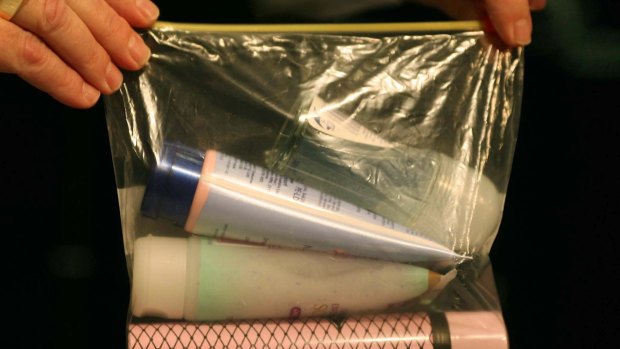This was published 9 years ago
No Christmas holiday for rules on liquids at airports
By JOE SHARKEY

The type of clear plastic bags that must be used for any liquids, aerosols or gels taken on international flights.Credit: LEE BESFORD
At an airport international checkpoint in Zurich recently, Leonard Berkowitz had a small bottle of shampoo and a tube of toothpaste confiscated before a trip home.
"The toothpaste was a little over the size limit, agreed, but I still thought it was a bit of overreaching," said Berkowitz, of Florida. "Anyway, I thought they were going to revise those rules on carrying liquids."
Revising the rules on liquids is a long-term goal, but nothing is imminent, according to the USA's Transportation Security Administration, which works closely with other security agencies internationally to coordinate policies.
Still, Berkowitz and many other frequent travellers I hear from often express bewilderment about rules on carrying liquids and gels onto airplanes. The vexation increases at the year-end holidays.
This is a time when even the most savvy business travellers, normally expert at efficiently navigating airport security, might be travelling with extra baggage in the form of presents, perhaps including that Christmas-gift bottle of high-end bourbon someone gave you, not to mention those Christmas snow globes - though the Transportation Security Administration now lets them through if they appear to contain less than 100 millilitres of liquid.
The liquids limits can pose problems for holiday travel. Does that container of mum's famous holiday creamed spinach that she insisted you take home get a pass at security? How about that salsa, or that pie your sister made? What about wrapped gifts? As to presents, the TSA says a screener "may have to unwrap a gift to take a closer look inside."
The liquids limits are, of course, complex to enforce and often confounding to travellers. However, aviation security officials stress that their biggest single fear is a terrorist plot to bomb airplanes using liquid explosives, like the foiled plot in 2006 in which terrorists were said to be planning to use liquid explosives in soft-drink containers to bring down 10 aircraft bound from Britain to North America.
"There are still some naysayers out there, still some people who say it's all security theater," John Pistole, the TSA administrator, said of complaints about liquids limits and other restrictions on what can be carried onto a plane. "But those folks just don't know what the threats are. One classified briefing on what the actual threats are would, hopefully, convince them - though some people are never convinced - that these threats are real and the stakes are high."
In fact, the TSA is now using electronic scanners that can identify potentially dangerous nonmetallic explosives, but these are used mainly to screen "medically necessary" liquids that are allowed through in quantities over the limits, provided they are presented separately for additional screening - which takes extra time at the checkpoints.
Technology companies are working to develop scanners to "allow most, if not all liquids, aerosols and gels to fly again," Pistole said. The hitch, he said, is to do this reliably and without creating additional checkpoint delays.
One small relaxation in the liquids rules occurred this year at airports in Europe, when the European Union relaxed some restrictions on bringing on board certain liquids, including bottles purchased at airport duty-free shops. Those containers must be in special duty-free bags, subject to additional screening with bottle-liquid scanning technology.
On the other hand, while most of us follow the rules on the amount of liquids in our carry-ons, like Brian Bodensteiner, of California, we also know that the additional requirement to remove those one-litre zipper-lock bags and present them for inspection is seldom followed, or enforced, at checkpoints.
"There's often a guy there at the checkpoint saying 'Take it out! Take it out!' But then they don't check to see if you do," he said. "For at least two years now, I've been stopped exactly never" for failing to remove allowable liquids from a carry-on.
However, he added, "on those times when I have a Nalgene bottle in my bag, which holds like 1 litre of water, and I forgot to dump it out, they'll catch it every time." This indicates, he suggests, and I agree, that the screeners are using common sense.
As part of its "risk based security" initiatives, the TSA gives screeners discretion in matters such as insisting that some passengers physically remove from their carry-ons otherwise compliant litre-size bags, readily identified in the standard X-ray scanning of all carry-ons. That strikes me as a common-sense approach.
And common sense is what we will all be happy to see even more of at the airports next year.
THE NEW YORK TIMES
Sign up for the Traveller newsletter
The latest travel news, tips and inspiration delivered to your inbox. Sign up now.